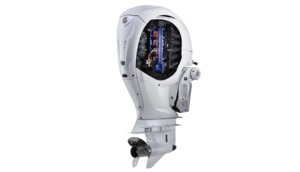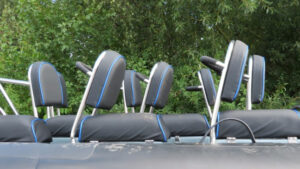In Focus: Competing ‘fuels of future’ holding industry back, says Archipelago

“What’s holding the industry back is there are competing ‘fuels of the future’ including hydrogen, ammonia, LNG and battery power,” says Dr. Stephen Weatherley (above). “All of the fuels have advantages and disadvantages, but we feel the leisure industry only has two viable choices: battery, for short distance operations, and methanol for longer distance and higher speed operations.”
The ‘we’ in this equation refers to Archipelago Expedition Yachts, of which he is founder and MD, and Chartwell Marine, naval architects.
“The industry isn’t making huge progress in this area because it’s genuinely complex. There is, of course, a lot of talk and not a huge amount of action (except in electrification), but for good reason.”
“Even if we take just methanol as a potential fuel – it’s a complex landscape: most current methanol production isn’t ‘green’, most harbours don’t have bunkering facilities, and there are no agreed regulations on methanol fuelling for leisure vessels.”
“That said, it’s a huge chicken-and-egg problem, because as soon as the boat building industry picks a fuel (eg methanol), the infrastructure will spring up very quickly, and demand for green methanol will grow, meaning production will increase. Clearly we may be wrong in our gamble that methanol is the future, but I feel it’s time to pick one and start moving forward.”
In 2022 Chartwell Marine’s consortium won an Innovate UK Smart Grant to design a full vessel (the Archipelago zero.63) and is now applying for grant funding (via CMDC and Innovate UK Smart Grant) to build a demonstrator vessel.
Building on that existing design, Weatherley believes that the conditions are right for methanol’s popular adoption. He says methanol is a widely traded commodity and it’ll be the smaller, more agile companies, focused on innovation and sustainability, such as Archipelago, who are going to drive uptake in leisure marine. Environmentally conscious yacht owners, those who are able to afford more expensive variants, are more likely to be the first owners of these boats.
“Like any emerging technology, there will be early adopters eager to push the boundaries, followed by a larger wave of individuals who prefer to witness the technology tested extensively before adopting it.
“I think it’s the only viable alternative for leisure vessels wanting to travel a reasonable distance. It will probably come down to regulation at some point in the future as to whether it’s adopted widely.”
“Acceptance and willingness within the maritime industry to transition to alternative fuels like methanol play a significant role. Incentives, subsidies, or government support for adopting cleaner fuels could encourage the uptake.”
Included on his list of challenges to adopting methanol are infrastructure limitations, technology and engine compatibility, regulatory uncertainty, public perception and awareness, and market acceptance and availability.
“Addressing these challenges requires a concerted effort from various stakeholders, including regulatory bodies, fuel suppliers, boat manufacturers, and technology developers, but as these challenges are navigated and mitigated, the prospects for wider adoption of methanol in leisure vessels will drastically improve.

“Currently, methanol adoption in the marine sector is more prevalent in experimental or pilot projects rather than widespread implementation. However, its potential to reduce emissions and comply with environmental regulations could drive further exploration and adoption in the coming years, especially if there are advancements in technology and infrastructure development.”
Weatherley says he’s currently talking to a number of customers in the commercial and leisure space about potential retrofits as methanol systems can be retrofitted to vessels.
“We are already seeing huge uptake in the commercial, large scale, shipping industry. A number of dual-fuel container ships have been ordered, which is going to drive significant demand for readily available bunkering fuel in ports.”
“Methanol is a widely traded chemical which can be delivered by tanker to the quayside. At the moment, there is no network within marinas / ports, although we are starting to see bunkering facilities in places like Rotterdam. This is a classic chicken-and-egg problem where demand is going to have to be there before marinas etc put in bunkering facilities.”

Weatherley’s guide to understanding methanol
Methanol can be produced in a large number of ways. Ultimately, it’s carbon, oxygen and hydrogen (CH3OH) in a molecule. The highest production globally comes from natural gas which is synthesised to produce methanol. There is a lot of global investment in green methanol which can be produced from low / zero or negative carbon sources such as eMethanol, which is made from carbon capture and green electricity. Also, it can be produced from decomposing biomass producing methane.
It is these greener alternatives (as opposed to ‘brown-methanol’ produced from coal) that make it a very attractive fuel source. Equally when methanol is burnt as a fuel it produces no sulphur dioxide, and very little nitrous oxide which means it is already IMO Tier 3 compliant.
In normal operational temperatures it is stored as a liquid. It disperses when in water, so is not harmful to the aquatic environment if spilt. It offers a relatively energy dense solution compared with some of the other alternative fuels available. It can also be produced with virtually zero, or even negative carbon footprint from sustainable sources.
The downsides are that it is a low-flashpoint fuel meaning (a little like petrol) and it is less energy dense than diesel, so can’t get the same range as a diesel vessel. Also, the bio alternatives are not yet readily available, so most of the methanol is not yet low carbon, but this is changing with demand from the marine industry.
There are two main ways to get energy out of methanol: firstly, it can be burnt in a standard (converted) combustion engine; secondly it can be ‘cracked’ in a reformer to produce hydrogen. This hydrogen is then fed into a standard hydrogen fuel cell. In the Archipelago zero.63’s design both methods of energy generation are used.










